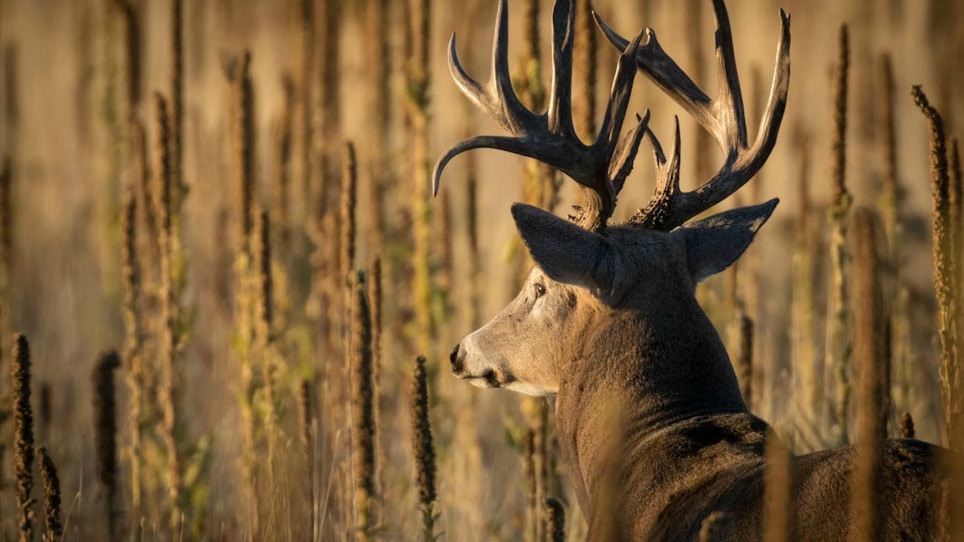
On some properties with zero hunting pressure, whitetails might take the path of least resistance, but most deer choose to stay in heavy cover as they travel between bedding and feeding areas. (Photo from Moutrie Products Facebook.)
My private hunting property for whitetails sits in the rough country of lower Brown County along the Ohio River. This locale of southwest Ohio is known for its nasty thickets, steep hills and deep ravines. It’s also known for its big mature bucks.
I have been hunting this land for nearly 30 years. The older I get I find that there is no path of least resistance in getting to any of my treestands. Big bucks on my land know this and use it to their advantage, but so do I.
Anyone who has ever read about whitetails has seen the notorious statement “deer take the path of least resistance.” From my experience this old cliché is bad advice and doesn’t exist in my woods. Maybe in non-pressured high-fenced areas, during summer, or on some outfitters for “big-name hunters only” types of hunting ground. In those rare cases, deer might take the easier route. Why shouldn’t they? They feel safe 90 percent of the time, except for the every now and then occasional disturbance from a celebrity and cameraman.
But what about whitetails that get pressured heavily during the entire bow/gun season? I hunt my private 100 acres with several close friends through the entire season two to four days a week, so it’s safe to say these deer are pressured. As a buck gets older and wiser, his survival skills go from “recruit” to “special forces” in a few short years, which means he no longer does things the easy way. He no longer takes “the path of least resistance.”
Take for example a morning hunt I was on years ago. My stand was positioned at the tip of a ravine that runs dead center through my property; a creek ran to my left and also to my right in the shape of a wishbone. The farther down the hill you go, the deeper each creek gets, and I mean it's "you need a rope to get out" deep. To my north is a small pond with a logging road — this easement is a classic saddle running from ridge to ridge, east to west. It’s a perfect “path of least resistance” for any deer coming through the middle of the property to seek bedding in the morning.
It was early October and had I hunted here only a handful of times so far, and I took extra measures on each of the hunts to make sure I didn’t alert the local deer that I was hunting them just yet. With a perfect south wind, a doe group appeared over the west ridge. They began their descent down the steep ridge. It would have been effortless for the lead matriarch doe to  angle along the ridge, dumping into the saddle that’s clean and easy to walk along. However, she led the group angling downward and away from my stand location into the steepest part of the ravine. There was a moment that the entire herd was in the creek bed and I couldn’t even see them from 20 feet high in my Summit climber! One by one they climbed out of the rugged terrain, keeping low, heading into the next deep creek and out of my bow range. An hour later, a 160-class buck came from the same area the does had previously. I didn’t even reach for my bow because I already had been busted. All I could do was watch this bruiser follow the same rocky trail the does navigated down.
angle along the ridge, dumping into the saddle that’s clean and easy to walk along. However, she led the group angling downward and away from my stand location into the steepest part of the ravine. There was a moment that the entire herd was in the creek bed and I couldn’t even see them from 20 feet high in my Summit climber! One by one they climbed out of the rugged terrain, keeping low, heading into the next deep creek and out of my bow range. An hour later, a 160-class buck came from the same area the does had previously. I didn’t even reach for my bow because I already had been busted. All I could do was watch this bruiser follow the same rocky trail the does navigated down.
At the end of that year’s hunting season, I immediately began to place my stand sites in the nastiest, roughest terrain I could find, and since then I have increased my success rate in taking mature bucks. So, if you are looking for a stand site and you have one of two options; option No. 1 being along a clearcut or logging road, and No. 2 being a place you wouldn’t want to walk through, up or around, I'd choose the latter. It has been my experience that the path of least resistance is for the birds, not the whitetails.





